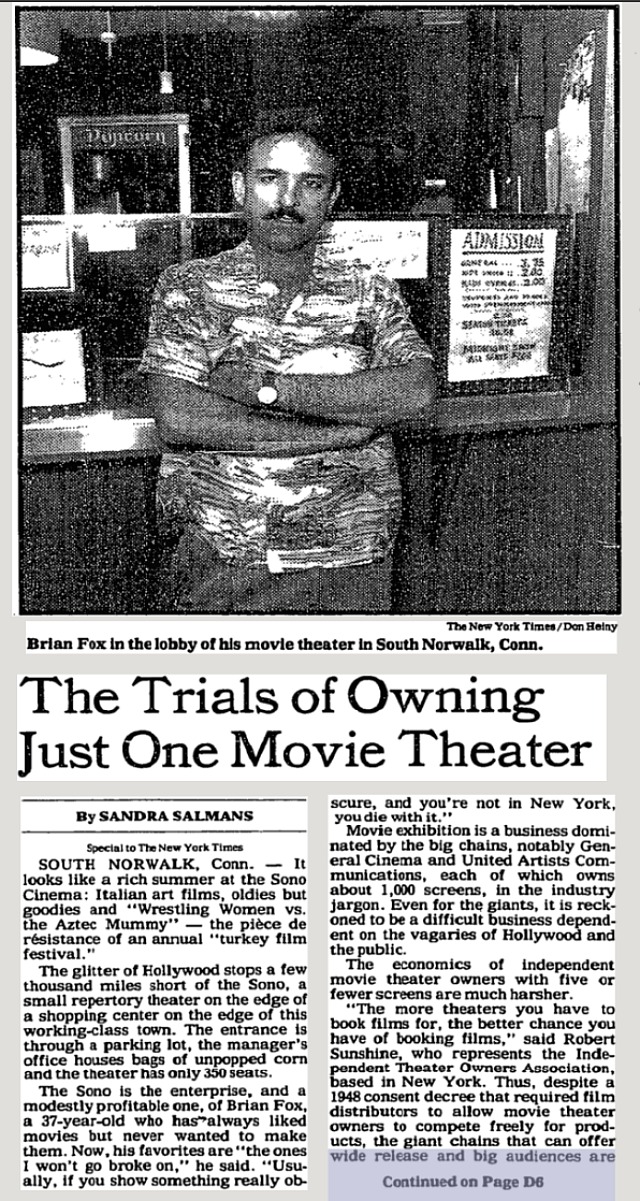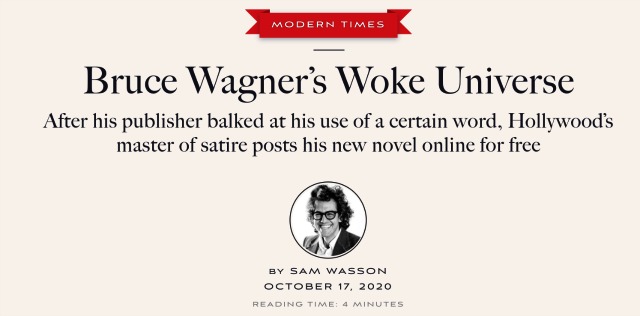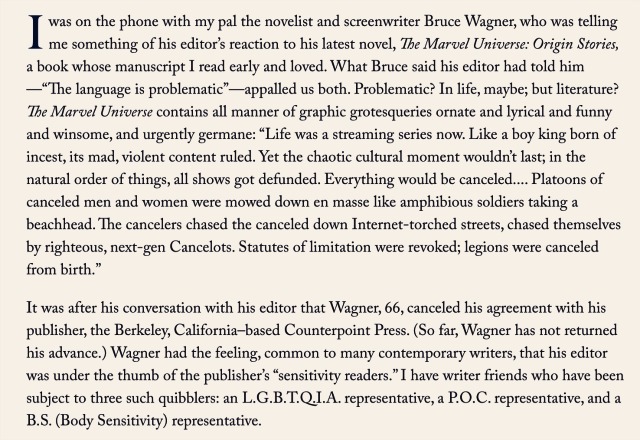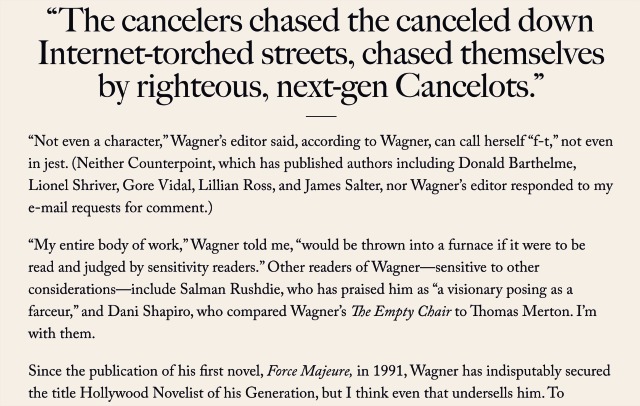

Imagine actually paying money to wear this godawful Sherlock Holmes fall jacket. (Or whatever you want to call it.) Imagine wearing the whole wretched outfit, including the whiteside workboots. Look at that printed shirt! Unbelievable.






Brian Fox, a respected repertory cinema owner and programmer from the ’70s and ’80s and a longtime friend of mine, passed last Monday evening. A massive heart attack. Condolences to his wife Diane, whom I’ve also known for decades. HE commenters knew Brian as “Grandpappy Amos.”
I met Brian though the Westport Playhouse Cinema, which he began co-managing with partner Fred Kraushar, in late ’76 or early ’77. I wrote program notes for the WPC as a kind of warm-up exercise before becoming a columnist for the fledgling Fairfield County Morning News. Then I moved to Sullivan Street in Soho and began my miserable period of freelance struggling and living hand-to-mouth — easily the darkest chapter of my professional life.
Brian was a personable, soft-spoken guy with a certain dry, droll attitude. He could be blunt in his own deft and darting way. I distinctly recall Brian calling me “a failure” during my arduous freelance agony days in ’79 and ’80. He didn’t mean to hurt my feelings exactly — it just came out that way. His assessment may have helped me on some level. It may have lit a fire.
I also recall a late-afternoon moment in ’77 when a young Hispanic guy and his girlfriend came into the WPC to talk about movies and pick up a printed program. As they were leaving and wishing the business well, Brian said “adios.” Fred was laughing his ass off at Brian’s faux pas two seconds after they’d left. One of those momentary embarassments that was quickly brushed under the carpet. It’s okay to mention it now. (Or is it?)
Brian and Diane were married in ’79. They tied the knot in a temple in Fairfield or Bridgeport. I was invited to attend a large post-wedding reception that was thrown by Brian’s dad, Morris, who was a crafty, level-headed, well-connected businessman. That day I sampled my first taste of anti-WASP ethnic prejudice. The reception was all about Morris’s business pallies, and Brian’s WASP friends were not, shall we say, treated with a great deal of familial warmth. We were seated right next to the kitchen with the door swinging open every 20 or 30 seconds. The message was “as friends of Brian, you guys are welcome but that’s all.”
In early ’79 Brian leased a South Norwalk porn theatre and turned it into the Sono Cinema, a Thalia- or Nuart-like arthouse that helped launch a cultural urban renewal initiative. I became a licensed projectionist around this time and occasionally worked in the Sono booth. (This was when I learned about aspect ratios, aperture plates and headroom.) The Sono Cinema was a thriving business for three or four years but then the burgeoning home video business began to eat into revenues. In the mid ’80s Brian tried a fundraising campaign to get out of debt, but eventually had to throw in the towel.
Residents of Durham, Brian and Diane have lived for decades in a nice, well-tended home with a large deck and beautiful backyard landscaping. They also own a condo in Belize, on Ambergris Caye.
Diane called with the bad news last night, two or three days after some news outlets had reported it.
She and Brian had just finished a nice meat loaf dinner. Brian stood up and said he was feeling badly, and then he sat on the couch and recanted (“I’m okay”). Then he began to drift in and out in terms of verbal coherence. Diane called an ambulance, and they took Brian out on a stretcher. He either died on the way to the hospital or once he got there.
No warnings from his primary physician, no cholestoral concerns, and Brian took exercise walks three times weekly…it happened just like that. His biological father, whom Brian never had much contact with, also passed from a heart attack at around the same advanced age.
Brian was my idea of an excellent fellow. He knew movies backwards and forwards. A serious Fassbinder fan.

Bill Maher last night (10.16.20): “The vast majority of Catholics are not scary, not doctrinaire. But there’s another strain of uber-conservative Catholics who have an agenda, and it’s really about pining for the return to the middle ages, when the church was the state. The attorney general is one of these people. So is the Federalist Society, [which is partly] responsible for putting five justices on the court. The Knights of Malta and Opus Dei. These old-school Catholics play the long game. Amy Barrett has been on their radar since forever, because she was raised in an extremist Catholic community called People of Praise, an organization [in which] a husband’s responsibilities may include ‘correcting’ his wife should she stray from a ‘proper path.'” And so on, etc.
Except for the Four Fakers aspect, Martin Scorsese‘s Rolling Thunder Revue: A Bob Dylan Story was pretty much a purely pleasurable experience for everyone who saw it during the summer of ’19. It’s been on Netflix ever since, of course. And now Criterion has a 4K Bluray version coming on 1.19.21.
What’s my richest musical recollection from Scorsese’s doc? Easy — Joni Mitchell playing the then-recently composed “Coyote” for Dylan, Roger McGuinn, Gordon Lightfoot and others at Lightfoot’s home during the tour. The clip, originally shot for Dylan’s misbegotten Renaldo and Clara, is on YouTube, of course. “Coyote” would go on to open Mitchell’s 1976 album Hejira but was in the early stages while Mitchell was performing on the RTR tour.
From “The Four Fakers,” posted on 6.10.19: To my mind the only serious problem with Martin Scorsese‘s Rolling Thunder Revue doc is that he includes four phony talking heads among several real ones, and thereby violates the trustworthiness that we all associate with the documentary form, and for a reason that strikes me as fanciful and bogus.

The doc acquaints us with 22 or more talking-head veterans of the tour (Dylan naturally included) but among this fraternity Scorsese inserts what Toronto Star critic Peter Howell is calling the “four fakers” — made-up characters portrayed by real, recognizable people.
Sharon Stone, who was 17 when the Rolling Thunder Tour was underway, seems to be speaking as herself but she’s actually “playing” The Beauty Queen. At first Michael Murphy seems to be speaking from his own perspective, but then you realize he’s playing The Politician. Actor-performer Martin von Haselberg (the husband of Bette Midler) plays The Filmmaker. And Paramount chairman and CEO Jim Gianopulos portrays The Promoter.
Some of what they say to the camera might be factually correct in this or that anecdotal way, but it’s all basically bullshit — made-up, written-out or improvised recollections that are performed for a chuckle, for the hell of it.
Scorsese explains his decision to include the four fakers in the press notes: “I wanted the picture to be a magic trick. Magic is the nature of film. There’s an element to the tour that has a sense of fun to it…doing something to the audience. You don’t make it predictable. There’s a great deal of sleight of hand.”
Who says RTR was driven by a sleight-of-hand, put-on mentality? I never heard that before. I thought it was about keeping it real, small-scale, people-level, driving around in a small tour bus, passing out pamphlets, etc.
Scorsese’s doc isn’t some fanciful, mask-wearing thing. 96% of it is just footage of Dylan’s ’75 Rolling Thunder tour throughout New England intercut with visual-aural references to what life was like back in the mid ’70s. The fact that it contains invented testimony from four fleeting fakers doesn’t dilute the basic composition. Perhaps the four fakers idea came from Scorsese’s regard for Italy’s Comedia dell’arte tradition.
In the process of reviewing Bruce Wagner‘s latest novel, “The Marvel Universe: Origin Stories“, Wagner’s editor at Counterpoint Press said that certain terms in the novel were “problematic,” first and foremost being the word “fat.”
Wokesters have banished the “f” word as flatly, decisively and eternally as the “n” word and other hateful epithets. I understand that, of course, and I know that the preferred term is “person of size” or, if you will, non-svelte. (“Calorically challenged” has always been frowned upon.) The long and the short is that Wagner was appalled at the editor’s refusal to allow the “f” word in his book, and for this and other reasons decided to self-publish the book for free.
Yes, I’ve used the “f” word a few times — Fat Thor, Fatzilla, etc. In late May of ’07 I was standing on a small bridge in Venice when I noticed a morbidly obese fellow and his wife reclining in a passing gondola, and the combined weight was such that the gondola was almost taking on water. “Wow, look at that fat guy,” I muttered to my son Jett, who was standing next to me. I knew I had misspoken. My voice had echoed slightly. Jett’s immediate response was to touch my forearm and go “sshhhhh.’
I’m not so stupid as to not understand that avoiding the “f” word is advisable. I get it. Of course. I realize. I’m just trying to get along. I am not a harshly judgmental person as a rule. I simply err on the side of offhanded candor from time to time.




In honor of yesterday’s Netflix debut of Aaron Sorkin‘s The Trial of the Chicago 7, here’s my original 9.25.20 review plus excerpts:
This is a truly exceptional smarthouse drama — a character-driven procedural that will hook adults of whatever age.
Despite the tumultuous late ’60s milieu Sorkin’s film is not about the usual noise, rage and chaotic energy, but about thought and procedure and agendas laid face-up on the table. It’s about clarity and drillbits and impressive brain-cell counts.
The endless Chicago 7 trial (September ’69 to February ’70) was about a Nixon administration attempt to nail eight anti-establishment activists for activities tied to violent conflicts during the August ’68 Chicago Democratic convention.
Four of the defendants were Abbie Hoffman, Tom Hayden, Jerry Rubin and activist David Dellinger, respectively played by Sacha Baron Cohen, Eddie Redmayne, Jeremy Strong and John Carroll Lynch. The idea was to convict them for violating the Rap Brown law by crossing state lines in order to incite a riot.
In so doing Nixon’s attorney general John Mitchell was ignoring a previous assessment by LBJ’s attorney general Ramsey Clark (Michael Keaton), which was that the conflict was primarily provoked by the Chicago police.
The number of defendants was reduced to seven when the attempted prosecution of Bobby Seale (Yahya Abdul-Mateen) was declared a mistrial.
The Trial of the Chicago 7 works because it’s all on the page — because of Sorkin’s shaping and honing — emphasizing and de-emphasizing to achieve a certain focus and tone. And then he assembled a top-tier cast and hired Phedon Papamichael to shoot it without any muss or fuss. Sorkin could’ve made a half-dozen other films about the Chicago 7 trial with all kinds of attitudes and approaches, but he decided to make this one.
The film’s central conflict is not a good guys vs. bad guys thing, but between Hayden and Hoffman — between their differing approaches to stoking or harnessing the social unrest.
Hayden’s approach was cerebral and sensible — classic political organizing, focused pragmatism, position papers, non-violence. Hoffman was about trusting in theatrical instinct — hippie-yippie tribalism, generational anger and a vaguely understood practice of cultural revolution for the hell of it (i.e., irreverence, impulsiveness, cranked-up emotion).
The Hayden approach dominates, certainly as far as the defense strategy is concerned, but Hoffman’s (and Rubin’s) wise-ass theatricality and flamboyance punches through.
It’s actually a kind of four-way debate by way of defense attorney William Kuntsler (played by the always-good Mark Rylance) and co-attorney Leonard Weinglass (Ben Shenkman).
But the payoff (and it’s a rouser) comes when Kuntsler decides to put Hoffman on the stand, which sets the stage for one of those robust Sorkin-crescendo moments.